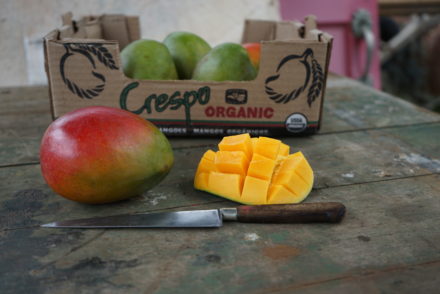Mature southern fruit + late Nayarit entrance = complex changeover
By definition the word foreground insinuates a seemingly larger position of prominence. I choose to use that word here as it’s important that we all understand the complexities that are looming in the mango world, as Mexico prepares to transition from the southern producing regions to the northern ones.
By no means it is a dire situation facing us, at least not for us, but it is one that will require us to work together in cooperation in order to keep things smooth for increasing sales and consumer satisfaction; consumers, who this time of year begin to consume more and more mangoes, as we need them to.
The northern regions of Nayarit and southern Sinaloa start back-to-back. They are rather large and long producing regions with extraordinary outputs in quantity. That wall of mangoes that ensues when these regions begin general production lasts around 3-4 months (and often longer) and coincides with peak consumer consumption or what we know as SUMMERTIME.
They key to moving through the upcoming transitional complexities and lack with enough finesse so that we can keep consumers happy, register pricing moving downward and mangoes flowing in and out quickly; so that we are ready for the even bigger displays, and even lower prices that move them rapidly into the hands and mouths of mango eaters, is as usual the sharing of real and accurate information from the ground in Mexico.
A wall of mangoes is just beyond this transition and we ready and commencing plans with many retailers for our Crespo Organic Summer Mango Mania #Muchos Mangoes campaign, which was created specifically as an answer to this wall of mangoes. This seasons campaign dates for have now are confirmed – June 12h – July 31st, mostly likely even extending into mid-august as it has for the last several years.
But for now, let’s just focus on the transitional details, which we have to move through gracefully first. What’s that wonderful Maya Angelou quote? “The more we know the better we do.” That’s the goal here.
We are now at the tail end for the southern region’s season and entering the period when the south ends and the north begins. Some seasons there is an easy overlap others times, like this year, there is not.
Typically, all of this happens in the middle to end of May. Depending on where the orchards are some southern region farmers (like us) can extend the southern region longer with strategically placed, late producing micro regions and combined with intricate techniques and approached designed specifically for the hot water treatment of mature fruit, which is the most significant issue with the late season fruit.
The transition complexities are always industry wide but they tends to be even tricker on the organic side of the equation, since there is simply a lot less production of organics, and very few organic orchards outside of Oaxaca and Chiapas in the south. On the conventional side they have large growing regions in Jalisco and Michoacan – both with their own challenges this season.
Overall volumes are lower once we pass the peak, that’s easy math to understand and important for us to think about. As overall volumes move downward in the south and Nayarit production is starting late (more on that in a minute) what we have in the southern orchards is finite and harder to predict.
Making matters worse in the southern regions are a few things. Michoacan and Oaxaca suffered some lack of bloom for the third bloom, which is yielding lower overall supplies. Coupled by faster maturing fruit due to hotter temperatures. The yield of the pack outs at the packhouse suffer because there is less usable fruit, which makes predicting quantities and sizing even more difficult. Mature fruit, however delicious it is, needs to have more attention to it in the supply chain, proper temperatures and quicker movement most importantly.
Size wise, this includes Ataulfos, there is currently a wide array of sizing coming from the orchards. And this will continue, the caveat is that some orchards are producing small, others large and it all adds to a lot more unpredictability than normal. Making total projected mango totals (mango pooling) even more difficult to predict.
We expect OUR southern region(s) Ataulfo crop to go through the middle of May- which technically means it will continue to move through retail channels through the third and fourth weeks. Meanwhile, lucky for us, our Nayarit Ataulfo season will begin harvest around mid-May and we project a fairly easy to deal with overlap. Ataulfos therefore seem to be the best promotable item for last two weeks of May for those that can’t wait until June. Many of the orchards left in the south are yielding smaller sized Ataulfos and most of the fruit is on the mature side, which most of our advanced Ataulfo programs can handle well. Nayarit is expected to have ample large fruit, so getting through to mid-May and past the first week of June is key for large Ataulfo customers.
The round mangoes from the south will go through mid-May with some of our orchards squeezing out fruit for the final weeks, enough to move us through to the Nayarit side, supplemented by some purchased product from other organic orchard from other regions and again our intricate extended practices in the orchards and packhouse.
Rains will dictate a lot, whether they come in the south or not. The more rain that comes during the end of the season, the less chance we have to extend it so weather will be key to any change of a smooth transition and something to watch for, closely.
Let this serve as a reminder to us that late season mangoes ripen faster (are also the sweetest!) so we plan to make sure we have optimal sale prices set to help them move through the system faster. Size specific sales on large volumes will be a challenge, we literally pick the last of what is available off the southern trees often without clear predictability on yields. That’s just the nature of this season’s transition. It’s not the first time its happened, nor will it be the last.
This is another reminded that our Crespo Organic program serves programs so we have no plans of price gauging despite projections of several market eruptions in price. We feel strongly that our program customers need to be priced right now so we can price right for Summer Mango Mania– smoothly. ( The wall of mangoes is coming!)
Nayarit round mango start is the real problem of this season’s transition since there is no beneficial overlap. We expect to start cutting round mangoes in both the Nayarit region as well as some of our southernmost production areas in Sinaloa around the 1st of June and assumptions are likely sooner as hotter temps continue in the area.
So, the real challenge for this Mexican mango transition will be the last two weeks of May, more so for the organic but also on the CV side.
In order to facilitate this transition our main packhouse in Sinaloa (Empaque don Jorge I) is opening early, the first week of May. This way we can truck fruit from several regions and get it packed with ample room for cooling and monitoring for quality and then shipped . For the month of May, we will have our three packhouses in operation, upping our ability to successfully move our program customers through this tricky transition.
Northern Sinaloa is blooming and setting up nicely and we will have more details on the Sinaloa crop soon.
With strong communication and a little nimble movement, we can sneak by the trouble and directly into BIG sales of #MUCHOSMANGOES .
















No Comments